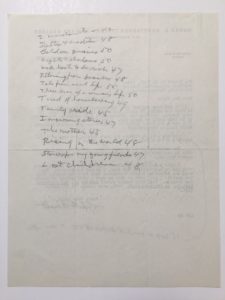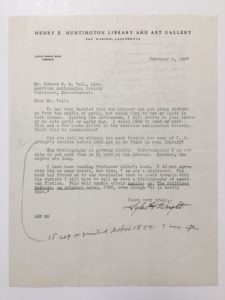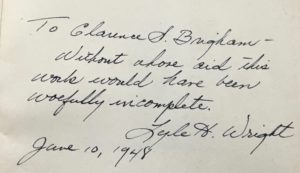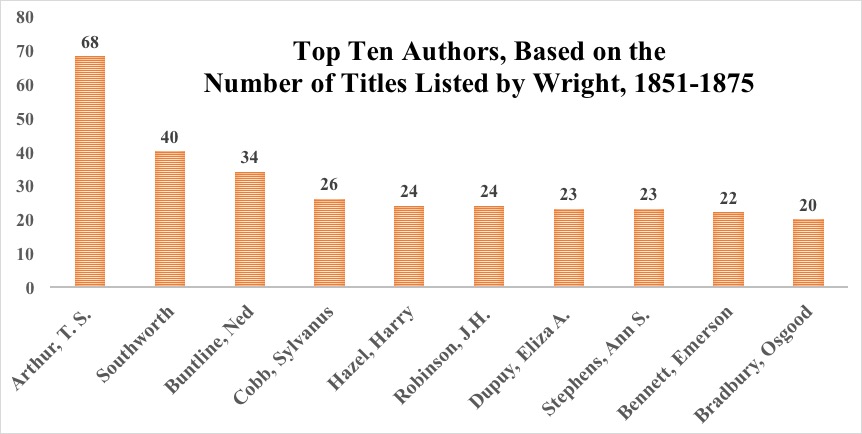Nigel Lepianka is a graduate student in the English Department at Texas A&M. He recently spent a month under the generous dome researching his dissertation, “‘Yet of Books There Are A Plenty’: The Bibliography of Literary Data.” Nigel and AAS Director for Digital and Book History Initiatives Molly Hardy co-authored this post.
The trend towards using catalog data to analyze bibliographic data continues as the Library of Congress recently announced that they have “opened their catalogs to the world.” This means that they have made 25 million records created between 1968 to 2014 available in bulk. We at AAS who work on the American printing record prior to 1900 don’t deal in such largess, and yet, data downloads of any size can be daunting. How do I know that I am getting all of the records for a given set of criteria — say, all books printed in Philadelphia from 1790-1800? When the criteria are temporal and spatial and when you are working with a comprehensive data set like the North American Imprint Program (NAIP), you can be pretty certain. But, what about when you are looking for types of authors or of books? Just as we are underway to enable increasingly users to be able to search for “blacks as authors” or have made it possible to search American reprints of English prose and verse before the Revolution, we also want to make it possible to search for “fiction” as a category. As a genre term, “fiction” can be very sticky, and so rather than reassessing thousands of records ourselves and deciding which to label as fiction, we did what we often do: we included citations to the definitive bibliography on the subject. In this case, we used volume two of Lyle Henry Wright’s three-volume American Fiction, 1774-1900. In volume two, Wright lists “the American editions of novels, novelettes, tales, romances, short stories and allegories, in prose, written by Americans” from 1851 to 1875. Wright excludes from his list “annuals and gift books, publications of the American Tract Society and the Sunday School Union, juveniles, fictitious Indian captivities, jestbooks, folklore, collections of anecdotes, periodicals, and extra numbers of periodicals.”
Using Wright as a basis for the improvement of fiction title metadata is a choice that is far more precedented for the Society than one might imagine. During the composition of the bibliography, particularly the first volume covering 1774-1850, Wright spent a decent portion of the leave he received from the Huntington Library at the AAS. Several decades of both publishing and revising the three volumes produced a robust collection of letters between Wright and AAS staff inquiring about titles, potential authors, editions, and the various minutiae of bibliographic detail amidst more genial discussions of the how-is-the-weather sort. These letters even include a suggestion by Robert Vail for Wright to read Arthur Hobson Quinn’s American Fiction: An Historical and Critical Survey (1936), which would ultimately inform Wright’s decision to use the term “fiction” over “novel” in the bibliography “to avoid trouble with the purists.”


AAS itself has invested in the Wright bibliography periodically to inform its holdings. Several copies of the first and second volumes of American Fiction are held in the AAS; they point to both physical, intellectual, and institutional labor spent in thinking about Wright’s listings. For the first volume, there are four copies of the published bibliography and a mimeograph checklist composed by Wright before publication. These copies include handwritten annotations and notes for particular titles listed by Wright as the Society acquired them. Wright already included in his descriptions the libraries in which he found a particular title, but the AAS staff in several cases continued to point out the evolution of their holdings in respect to American fiction. As Wright revised the first volume for the 1948 edition, he incorporated approximately 600 more titles and editions. Of these, close to 100 titles were found penciled in by AAS in the earlier 1939 edition. In the flip book below, see for example, the expansion of the entries for “Goodrich, Samuel Griswold” from half a page in the 1939 edition to two pages in the 1948 edition to three pages in the 1969 edition based on Clarence Brigham’s pencilled notes in the 1935 edition.
[book id=’29? /]
It is no surprise then that Wright included this dedication to the 1948 edition of his bibliography he gave to the Society, “To Clarence S. Brigham — Without whose aid this work would have been woefully incomplete.”

This sort of collaborative effort would continue, as acquisitions of fiction would continue to be described as either “Found in Wright” or “Not in Wright.” The 1969 edition would feature corrections grafted physically into the book that attempted to append authors to anonymous titles.
Given AAS’s longstanding relationship with Wright and his work, the Society has been including Wright numbers as catalogers came across records for included titles, either in cataloging nineteenth-century imprints or in enhancing recon records. But, thanks to the University of Indiana’s Wright American Fiction 1851-1875 project we now have comprehensive records for volume 2 of Wright. The Indiana project includes 2,340 texts included (2,040 unedited and lightly encoded, 300 fully edited and encoded). The University of Indiana library generously gave us their MARC records for these texts. These records include links to each of the images of and encoded texts in Wright II, but they also enable analysis of the bibliographic data contained in the records. We have enhanced the records by adding to each a field (or fields) listing in hierarchical fashion the place (or places) of publication named in the imprint (e.g. United States–Pennsylvania–Philadelphia). This enables the geo-locating of these records. We are in the process of further enhancing the records by adding the heading “Women as authors” to all works written by women. Already, we can see the top ten authors based on the number of titles Wright lists.

These names might come as a bit of a surprise. Timothy Shay Arthur and not Harriet Beecher Stowe? Really? It is hard to imagine that Arthur’s Ten Nights in a Bar-Room, and What I Saw There could beat out Uncle Tom’s Cabin, say. Wright himself acknowledges this when he reflects on his work for the second volume in the AAS Proceedings, describing Arthur as a “classic example of an author who ground out one hundred or more books during his lifetime, yet was unable to attain the rank of a literary craftsman.” Wright nevertheless acknowledges Shay’s success, writing “…it cannot be denied that his saccharine tales were tremendously popular and influenced the thinking of a large body of his readers.” Repeated Wright entries are indeed indications of proliferation. Multiple editions of a given book did not receive their own entry; instead, they are merely listed under the original edition’s entry.
While Wright’s bibliography is a hallmark of both traditional bibliography and American literary study, it has gained new life in an age that has increasingly seen scholars turn towards questions of scale, database, and distant reading. The composition of Wright’s work as a classical enumerative bibliography demonstrates an ethos that more contemporary distant reading scholars have recently professed. A bibliography such as a Wright’s, while not perfect when you consider his exclusions (i.e. Walt Whitman’s Franklin Evans or Louisa May Alcott’s Little Women) and problematic inclusions (i.e. Harriet Jacobs’ autobiographical Incidents in a list of fiction), represents effort, attention to, and documentation of what Franco Moretti calls the “Slaughterhouse of Literature”, though more recently scholars such as Ted Underwood would question the ethos of the slaughterhouse over more controlled collections. The point, however, is Wright produced a dataset, that can be explored, modeled, and read (and IU and now NAIP have assisted in delivering this). Within this dataset there is an attempt (at the least) to describe those that exist beyond the canon in a way that is synonymous with the democratic “one vote” principle: Moby-Dick, The Scarlet Letter, and Uncle Tom’s Cabin receive one entry. Wright himself embodies this ethos years before when he, echoing the sentiments of the New Bibliography tradition, asserts that it is a “bibliographic impossibility” to say that a text should not be described in a list.
